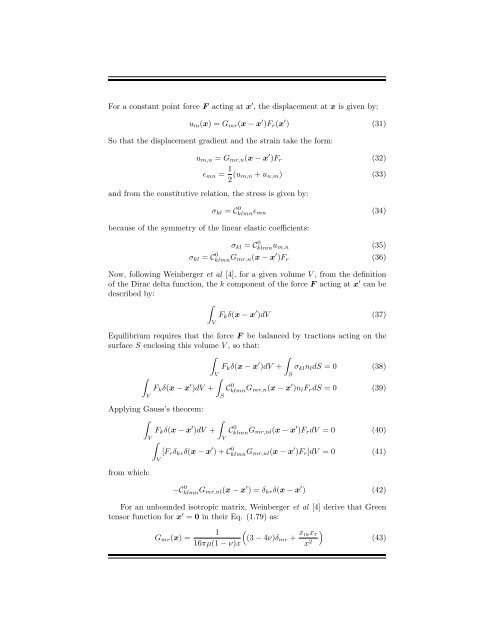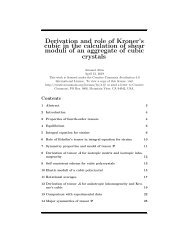Create successful ePaper yourself
Turn your PDF publications into a flip-book with our unique Google optimized e-Paper software.
For a constant point force F acting at x ′ , the displacement at x is given by:<br />
u m (x) = G mr (x − x ′ )F r (x ′ ) (31)<br />
So that the displacement gradient and the strain take the form:<br />
u m,n = G mr,n (x − x ′ )F r (32)<br />
ɛ mn = 1 2 (u m,n + u n,m ) (33)<br />
and from the constitutive relation, the stress is given by:<br />
σ kl = C 0 klmnɛ mn (34)<br />
because of the symmetry of the linear elastic coefficients:<br />
σ kl = C 0 klmnu m,n (35)<br />
σ kl = C 0 klmnG mr,n (x − x ′ )F r (36)<br />
Now, following Weinberger et al [4], for a given volume V , from the definition<br />
of the Dirac delta function, the k component of the force F acting at x ′ can be<br />
described by:<br />
∫<br />
F k δ(x − x ′ )dV (37)<br />
V<br />
Equilibrium requires that the force F be balanced by tractions acting on the<br />
surface S enclosing this volume V , so that:<br />
∫<br />
∫<br />
F k δ(x − x ′ )dV + σ kl n l dS = 0 (38)<br />
V<br />
S<br />
∫<br />
∫<br />
F k δ(x − x ′ )dV + CklmnG 0 mr,n (x − x ′ )n l F r dS = 0 (39)<br />
V<br />
S<br />
Applying Gauss’s theorem:<br />
∫<br />
∫<br />
F k δ(x − x ′ )dV + CklmnG 0 mr,nl (x − x ′ )F r dV = 0 (40)<br />
V<br />
V<br />
∫<br />
[F r δ kr δ(x − x ′ ) + CklmnG 0 mr,nl (x − x ′ )F r ]dV = 0 (41)<br />
from which:<br />
V<br />
−C 0 klmnG mr,nl (x − x ′ ) = δ kr δ(x − x ′ ) (42)<br />
For an unbounded isotropic matrix, Weinberger et al [4] derive that Green<br />
tensor function for x ′ = 0 in their Eq. (1.79) as:<br />
G mr (x) =<br />
1<br />
(<br />
(3 − 4ν)δ mr + x )<br />
mx r<br />
16πµ(1 − ν)x<br />
x 2<br />
(43)



